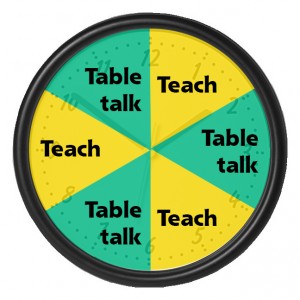In church we love the 25- to 45-minute teaching monologue. Sermons, seminars and Sunday classes are usually built on this format. A speaker stands before a crowd and makes a series of points designed to lead the audience to a predetermined conclusion. Then, based on this logical discourse, lives are supposedly changed. Sometimes this method works. Most of the time it doesn’t – especially with men.

Men’s ministry meetings usually follow a similar line: a 30- to 40-minute presentation (live or video) followed by 15 to 20 minutes of table talk. Some guys even skip out on the talk time (“Sorry guys, I gotta be at work in a few minutes!”).
This listen-then-talk model is so ingrained in men’s ministry that we hardly question it. Yet no one ever seems to ask if this format is the best way to build relationships or train disciples.
I don’t believe it is–particularly when it comes to men.
The average man can pay close attention to a monologue lecture for about 10 minutes. After that his mind will tend to wander.
A few years ago, after Why Men Hate Going to Church hit the bookshelves, I began speaking to groups. I did the usual: talk for 40 minutes. It wasn’t long before I noticed men dropping off after 12 minutes or so. I thought I was a bad speaker–until I looked around during other presenters’ talks and noticed the same thing happening. Ditto during sermons at church.
So I decided to try something different. If guys pay close attention for ten minutes, then that’s how long I’ll teach. I designed a retreat weekend around a 10-10 teaching format.
The first thing I do is put the guys into small discussion teams of 2, 3 or 4. Then I speak for 10 minutes. Next, I project questions on a screen. Each team takes 10 minutes to discuss the questions. Then I teach 10 more minutes, and so on.

Here’s what I’ve learned about the 10-10 format:
- The number of men who nod off or check their phones has decreased by 80%.
- The amount of table talk has doubled.
- Men pay closer attention to what I’m saying because they know talk time is coming and they have to be ready to answer the questions.
- Guys can’t skip out on talk time.
- Everyone gets a chance to participate.
- Men regularly tell me my retreats are the best ever, even though I talk much less than the average retreat speaker.
- Men have more opportunities to build friendships.
Let me comment on that last point: guys can get great teaching anywhere. But friendships are hard to come by.
The church’s “core product” is not Bible teaching — it’s love. Jesus told his disciples to love one another. The 10-10 format gives men an opportunity to share their stories, get to know one another and support one another. The 10-10 format is designed to build friendships, particularly if you assign guys to groups of three and ask them to sit together every week.
The monologue model sends a powerful message: you are here to receive information from an expert. The 10-10 model sends a different message: you are here to be known and loved.
So the next time you teach, try a 10-10 format. Let me know how it goes.
Here’s a short video with testimonies from guys who have experienced the 10-10 format:
 David Murrow is the author of the bestselling book, Why Men Hate Going to Church. David’s books have sold more than 175,000 copies in 12 languages. He speaks to groups around the world about Christianity’s persistent gender gap. He lives in Alaska with his wife of more than 30 years, professional silk artist Gina Murrow. Learn more about David at his Web site, www.churchformen.com, or join the conversation on his Facebook page, www.facebook.com/churchformen. Don’t forget to share this page by clicking on the links below, or scroll down and leave a comment (right below those annoying ads that pay for this blog).
David Murrow is the author of the bestselling book, Why Men Hate Going to Church. David’s books have sold more than 175,000 copies in 12 languages. He speaks to groups around the world about Christianity’s persistent gender gap. He lives in Alaska with his wife of more than 30 years, professional silk artist Gina Murrow. Learn more about David at his Web site, www.churchformen.com, or join the conversation on his Facebook page, www.facebook.com/churchformen. Don’t forget to share this page by clicking on the links below, or scroll down and leave a comment (right below those annoying ads that pay for this blog).
















